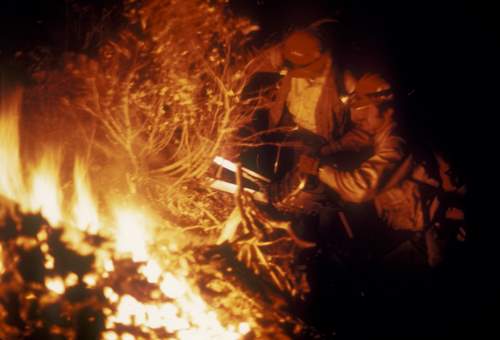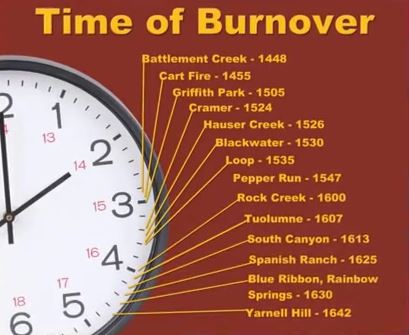Firefighters — Don’t squander the early morning hours
The folks at the National Interagency Fire Center have produced a video titled WFSTAR: An Analysis of Burnovers. They do not tell us what “WFSTAR” stands for, but our best guess is Wildland Fire Safety Training Annual Refresher.
The video presents findings from an analysis of fatalities on wildland fires. One of the more interesting pieces of information was the time of day that many of the fatalities occurred.
Sixteen of the burnover incidents occurred during a two hour period, between 1448 and 1642. The blowups that led to the fatalities occurred an average of 24 minutes earlier.
Experienced firefighters know that large fires are typically most active in the mid-afternoon. Solar heating has reached it’s peak. The ground, vegetation, and air are as hot as they will be all day. It is not uncommon for firefighters to have to pull back and abandon what they were doing in the afternoon and retreat to a safety zone because the fire threatens to overrun their position. Firelines painstakingly constructed can be lost. It is the hottest part of the day, sapping the energy of personnel and reducing their production while putting them at risk of heat-related injuries.
All of those factors can result in firefighters being least productive in the mid-afternoon. But if they are exhausted or hunkered down in a safety zone at 1500, what was going on at 0500? On some fires most everyone would still be asleep, or maybe slowly moving around looking for a cup of coffee, or standing in a chow line. At the same time out on the fireline, typically the fire would also be moving at a very slow pace. The ground, vegetation, and air are as cool as they will be all day. The relative humidity and the fine fuel moistures are at their peaks. This is the perfect time to take advantage of decreased fire behavior. The cooler conditions are better for the personnel, who can be more productive, and they will have the advantage over the slower moving fire — the opposite of what happens in mid-afternoon.
Don’t squander the early morning hours.
Sometimes firefighters do not arrive at their work assignment on the fireline until mid to late morning. They may have squandered the time of day when the working conditions and the fire behavior were best suited for productive, safe work.
Incident Commanders and Incident Management Teams need to change their thinking on this.
For example, in July in Prescott, Arizona sunrise is at about 0530. The schedule for the day operational period could be something like this:
0230 or 0300 – Firefighters get up and eat breakfast
0330 – Briefing (lasting no more than 30 minutes)
0400 – Begin travel to fireline (assume one hour; it can be longer)
0500 – Firefighters arrive at their fireline assignment; helicopters can begin flying troops in if needed, air tankers can fly.
0530 – Sunrise
1630 to 1930 – off the clock back at fire camp
With this schedule firefighters could get in up to nine hours of actual fire suppression work before the least productive and most dangerous period of the day begins at 1400, compared to three to six hours with a typical schedule.
Fighting fire at night
The schedule above assumes that the fire managers, for whatever reason, have an aversion to fighting fire at night. In the last one to two decades, there have been fewer incident management teams willing to commit firefighters to the fireline after sunset. There can be good reasons for this, such as steep terrain with rolling rocks and logs that can difficult to see and avoid during darkness, or falling snags could be a serious hazard. But if these or other dangerous conditions do not exist, fire managers should consider that firefighters can frequently gain more ground when environmental conditions are better for working, and the fire is moving more slowly.
Check out http://groups.yahoo.com/group/californiadisasters/
Read my blog at http://eclecticarcania.blogspot.com/
My Facebook: http://www.facebook.com/derkimster
Linkedin profile: http://www.linkedin.com/pub/kim-noyes/9/3a1/2b8
Follow me on Twitter @DisasterKim
__._,_.___


No comments:
Post a Comment